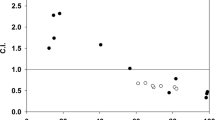Abstract
X-ray crystallographic and biochemical investigation of the reaction of cisplatin and oxaliplatin with nucleosome core particle and naked DNA reveals that histone octamer association can modulate DNA platination. Adduct formation also occurs at specific histone methionine residues, which could serve as a nuclear platinum reservoir influencing adduct transfer to DNA. Our findings suggest that the nucleosome center may provide a favorable target for the design of improved platinum anticancer drugs.
This is a preview of subscription content, access via your institution
Access options
Subscribe to this journal
Receive 12 print issues and online access
$259.00 per year
only $21.58 per issue
Buy this article
- Purchase on Springer Link
- Instant access to full article PDF
Prices may be subject to local taxes which are calculated during checkout


Similar content being viewed by others
Change history
03 January 2008
dash marks added back into Fig 2a
References
Jung, Y. & Lippard, S.J. Chem. Rev. 107, 1387–1407 (2007).
Segal, E. et al. Nature 442, 772–778 (2006).
Galea, A.M. & Murray, V. Biochim. Biophys. Acta 1579, 142–152 (2002).
Wang, D., Hara, R., Singh, G., Sancar, A. & Lippard, S.J. Biochemistry 42, 6747–6753 (2003).
Richmond, T.J. & Davey, C.A. Nature 423, 145–150 (2003).
Ong, M.S., Richmond, T.J. & Davey, C.A. J. Mol. Biol. 368, 1067–1074 (2007).
Davey, C.A. & Richmond, T.J. Proc. Natl. Acad. Sci. USA 99, 11169–11174 (2002).
Royer-Pokora, B., Gordon, L.K. & Haseltine, W.A. Nucleic Acids Res. 9, 4595–4609 (1981).
Trzupek, J.D., Gottesfeld, J.M. & Boger, D.L. Nat. Chem. Biol. 2, 79–82 (2006).
Subramanian, V., Ducept, P., Williams, R.M. & Luger, K. Chem. Biol. 14, 553–563 (2007).
Li, G., Levitus, M., Bustamante, C. & Widom, J. Nat. Struct. Mol. Biol. 12, 46–53 (2005).
Davey, C.A., Sargent, D.F., Luger, K., Maeder, A.W. & Richmond, T.J. J. Mol. Biol. 319, 1097–1113 (2002).
Murray, V. et al. J. Biol. Chem. 267, 18805–18809 (1992).
Woynarowski, J.M., Chapman, W.G., Napier, C., Herzig, M.C. & Juniewicz, P. Mol. Pharmacol. 54, 770–777 (1998).
Reedijk, J. Proc. Natl. Acad. Sci. USA 100, 3611–3616 (2003).
Barnham, K.J., Djuran, M.I., Murdoch, P.D., Ranford, J.D. & Sadler, P.J. J. Chem. Soc. Dalton Trans. 22, 3721–3726 (1995).
Spingler, B., Whittington, D.A. & Lippard, S.J. Inorg. Chem. 40, 5596–5602 (2001).
Acknowledgements
C.A.D. dedicates this work to the memory of Lois Joan Varallo. Thanks to D. Vasudevan, K.A. Mohideen, C. Schulze-Briese and staff at the X06SA beam line of the Swiss Light Source for assistance with data collection. C.A.D. is very grateful to G.E. Davey for input on the manuscript and unreserved support. This work was supported by a Nanyang Technological University grant and an Academic Research Council grant from the Ministry of Education, Singapore.
Author information
Authors and Affiliations
Contributions
B.W. planned and performed experiments; P.D. provided expertise for footprinting analysis and input on the manuscript; C.A.D. designed research, conducted analysis and wrote the manuscript.
Corresponding author
Supplementary information
Supplementary Text and Figures
Supplementary Figures 1–3, Supplementary Tables 1–3 and Supplementary Methods (PDF 677 kb)
Rights and permissions
About this article
Cite this article
Wu, B., Dröge, P. & Davey, C. Site selectivity of platinum anticancer therapeutics. Nat Chem Biol 4, 110–112 (2008). https://doi.org/10.1038/nchembio.2007.58
Received:
Accepted:
Published:
Issue Date:
DOI: https://doi.org/10.1038/nchembio.2007.58
This article is cited by
-
Simultaneous mass spectrometry analysis of cisplatin with oligonucleotide-peptide mixtures: implications for the mechanism of action
JBIC Journal of Biological Inorganic Chemistry (2022)
-
DNA damage in nucleosomes
Science China Chemistry (2019)
-
Intra- and inter-nucleosomal interactions of the histone H4 tail revealed with a human nucleosome core particle with genetically-incorporated H4 tetra-acetylation
Scientific Reports (2015)
-
Ligand substitutions between ruthenium–cymene compounds can control protein versus DNA targeting and anticancer activity
Nature Communications (2014)
-
Anticancer metallodrug research analytically painting the “omics” picture—current developments and future trends
Analytical and Bioanalytical Chemistry (2013)



